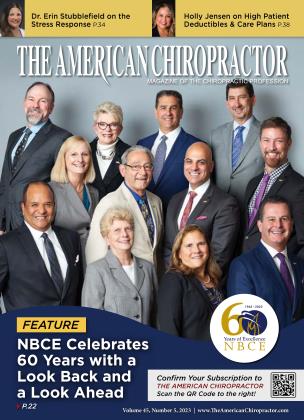Paradoxical Motion of C5
RESEARCH
A Preliminary Report on a New Study of 200 Chiropractic Patients with Neck Pain
Richard M. Opper
DC
When analyzing and treating the cervical spine, the chiropractic toolbox is full of devices, salves, pills, common practices, and not-so-common practices. Reliance on X-rays to identify pathomechanics and support an adjusting protocol is not universally understood. The early findings of an ongoing retrospective study of 200 lateral cervical X-rays of chiropractic patients who complained of neck pain reveal a significant correlation between the effect of paradoxical motion of C5 to the incidence (73%) of hypolordosis. The malalignment of C5 in these cases is that of a distinctly severe subluxation, which may even be classified as a dislocation.
A study published in 1964 and referenced in Clinical Biomechanics of the Spine (Panjabi and White 2nd ed.
i99U, CP 2, kinematics ot the spine, pX8-89; A J Lippincott) discovered that when the head and neck were suddenly flexed or extended, C5 moved in the opposite direction or paradoxically.[1] The method used in that study was motion X-rays or “cineroentgenography.” A decade later, W.V. Pierce, DC, used video radiography and found that C5 was locked or fixed when hypolordotic cervical spines were flexed or extended. The original study showed that C5 rotated backward on its X-axis (R-X-axis), downward on its Y-axis (-Y-axis), and translated forward on its Z-axis (+Z-axis) when the head and neck were extended. When the head and neck were flexed, C5 was seen to move in opposite directions, except that its motion on the Y-axis was also downward. The current study reveals that disc degeneration occurs much more frequently above and below C5 and most often at level C5-6. The disc angles are most frequently reversed or greatly altered at those same levels. Thirteen of 16 X-rays that demonstrated stage-one hypolordosis, which is when only one vertebra has moved posteriorly away from the normal lordotic curve line, revealed C5 to be the offending segment. C1 and C2 were not involved in the sagittal distortion seen on 146 of the 200 films, and C7 was rarely found to be part of the hypolordosis. This study shows evidence that the C7 sagittal vertical axis (SVA), or gravity line, normally bisects the bodies of C7 and C2 but bisects C7 and touches C5 in the hypolordotic spine, and falls posterior to C2. Forward head posture is consistent but mild in these cases, measuring 1-2 cm. Moderate to severe FHP did not correlate with hypolordosis.
Clinical considerations in cases of neck pain after the history and examination are completed should include a five-view series of X-rays. A treatment regimen to restore mobility and reduce pain is inadequate if C5 remains subluxated/dislocated; otherwise, symptoms may recur, and the spine will continue to degenerate and become kyphotic.[2] That is why victims of acceleration/ deceleration injuries often experience symptoms many years after the injury and after the initial treatment program. [3] The clinician needs to be aware of the likelihood of attendant soft-tissue injury above and below C5. Disruption of the anterior and posterior ligaments needs to be considered before aggressive therapies are applied. The ALL can rupture at C4-C5 and the PLL at C5-6 in an acceleration injury, and the ALL can rupture at C5-6 and the PLL at C4-5 during a deceleration injury.[4] When impact speeds approach 25 mph and greater, the incidence of fracture and mortality increase dramatically at those levels. The potential for an insult to the neural structures is always a consideration. The diagnosis of “sprain/ strain” subsequent to injuries where the mechanism produced hyperflexion or extension is most often inaccurate when C5 is subluxated. The consequence to the patient in the long term may be significant.
One theory is that C5 serves as a reflexive braking mechanism to stabilize the spine when it is flexed or extended.
The exact mechanism that causes C5 to move paradoxically to linear forces is unknown. C5 has some unique characteristics; the pivot point of the cervical spine during flexion occurs at the posterior superior space above C5, and when in extension, it’s at the posterior inferior space below C5. There are six neck muscles that influence its motion, whereas the other typical cervical vertebrae have three or fewer. One theory is that C5 serves as a reflexive braking mechanism to stabilize the spine when it is flexed or extended. For example, when it is forced into an extension, the anterior lateral muscles might respond with a stretch reflex and pull C5 forward and down. When the neck is forced into flexion, the cervical branches of the erector spinae might pull it superior and posterior. The data from this study, while incomplete, reveals that C5 is the most frequent participant in the 484 instances of pathomechanics identified on these 200 X-rays.
Dr. Opper is a 1969 graduate of The Columbia Institute of Chiropractic, Partner in Palmer Chiropractic PC, Palmer, Mass. Authored: "Paradoxical Motion of The Cervical Spine...." JACA, Jan, 2000; Article under review: "Adolescent Idiopathic Scoliosis is an Etiotropic Remodeling of The Spine in Response to Disequilibrium". [email protected]
References
1.FIELDING JW. NORMAL AND SELECTED ABNORMAL MOTION OF THE CERIICAL SPINE FROM THE SECOND CERIICAL JERTEBRA TO THE SEVENTH CERVICAL VERTEBRA BASED ON CINEROENTGENOGRAPHY. J Bone Joint Surg Am. 1964 Dec;46:1779-81. PMID: 14239869.
2. Fakhonry J, Dowling TJ. Cervical Degenerative Disc Disease; pathophysiology. 2021 Aug 25. In: StatPearls [Internet], Treasure Island (FL): StatPearls Publishing; 2022 Jan—. PMID
3. : Jackson, R. 1977. The Cervical Syndrome; etiology; 4: 90-82, . Springfield, III.: Charles C. Thomas
4. . Bitterling H, Stabler A, Briickmann H. Mysterium Ligamentum alare Ruptur: Stellerrwert der MRT-Diagnostik des Schleudertraumas-biomechanische, anatomische und klinische Studien [Mystery of alar ligament rupture: value ofMRI in whiplash
 View Full Issue
View Full Issue






